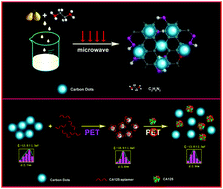Nitrogen doped carbon dots: mechanism investigation and their application for label free CA125 analysis†
Abstract
Doping with heteroatoms (such as nitrogen doping) is an attractive and efficient strategy to enhance the quantum yield of carbon dots. However, the influence of the nitrogen doping on the carbon dots is relatively scarcely reported. In this work, nitrogen-doped CDs (N-CDs) with high fluorescence quantum yield were firstly prepared by using pear juice as the carbon source and ethanediamine as a nitrogen doping precursor with a microwave assisted pyrolysis technique. We systematically investigated the mechanism of fluorescence enhancement resulting from the nitrogen doping by using density functional theory (DFT) calculations, X-ray photoelectron spectroscopy (XPS), Raman spectroscopy and fluorescence lifetime measurements. Based on the fluorescence recovery induced by competitive adsorption and desorption of CA125-aptamers on the surface of the N-CDs, a label-free “turn on” fluorescence assay with high sensitivity and selectivity was proposed for the analysis of CA125, providing a broad linear range from 0.1 U mL−1 to 16 U mL−1 with a detection limit of 0.035 U mL−1. Moreover, the proposed label-free “turn on” fluorescence assay can also be successfully applied to the detection of CA125 in human serum samples from healthy people and ovarian cancer patients, indicating available diagnostic applications.



 Please wait while we load your content...
Please wait while we load your content...